Plants
Animals
Ecosystems
|
 |
|
PROJECT DESCRIPTIONS |
|
|
Kudzu response to removal treatments Melissa Corbet and Michael Verble have created vegetative plots that vary in plant composition and vertical structure, as a consequence of differnt mowing frequencies and plant removal treatments. A pitfall trap has been placed in each plot, and they are sampling the carabid beetle communities in these plots to determine whether small or large scale differences exist that correlate with differences in the veegation at these scales.
|
 |
|
Effects of vegetation on beetles at several scales Melissa Corbet and Michael Verble are examining the effects of annual and monthly mowing, as well as clipping, herbicide, and competitors, on the growth of kudzu. When summer 2012 is complete, all plots will be mown and seeded with a variety of grassses used in restoration efforts. Then, they can determine whether the kudzu removal treatemtns had an effect on the performance of grasses used in restoration efforts. Michael is supported by a Furman Advantage grant, and Melissa is funded by a grant from the Independent Colleges and Universities of South Carolina consortium.
|
 |
|
Habitat preferences of carabid beetles David Merriman, class of 2012, studied the habitat preferences of carabid beetles in summer 2011. Twenty-four sites were selected, based on the plants surveys done previously, that varied in plant species richness, diversity, and composition. Pitfall traps were placed at each site, and correlational analyses were performed to see if beetle richness and diversity correlated with plant richness and diversity. They did not. Rather, carabid richness (and the baundance and dominance of C. goryi, the most abundant species) correlated with the size of trees. They were also most abundant in association with Tulip Poplar, rather than White Oak or Virginia Pine. These results suggest that carabids respond to stand age and prefere mesic habitats. David also found a new species for the state of South Carolina, Cyclotrachelus hyphespiformis. David was supported by a grant from the Independent Colleges and Universities of South Carolina consortium.
|
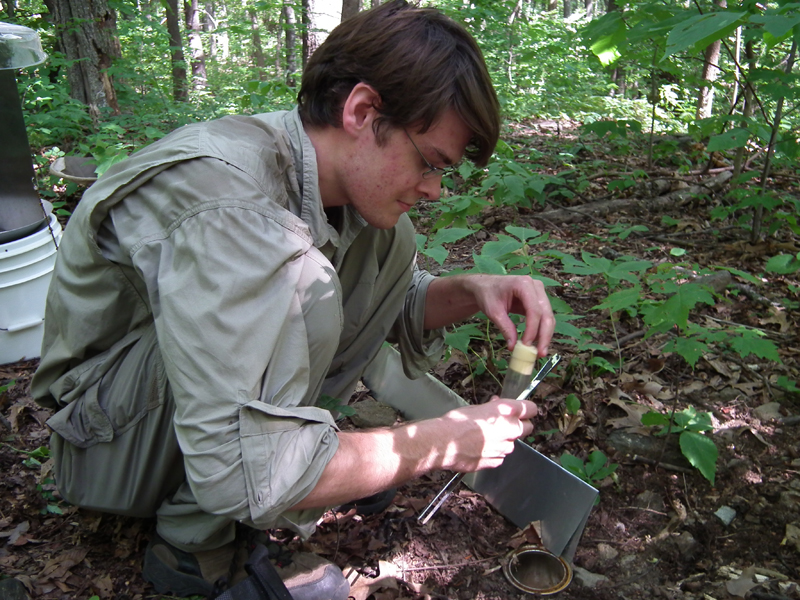 |
|
Survey of moths and butterflies at Furman Forest Amelia Schulz, class of 2013, conducted a survey of moths and butterflies at Furman Forest in summer 2011. Although the initial intent of the study was to see if moth and butterfly diveristy correlated with tree diversity, sampling problems arose that limited sampling to one sampling period for each site. Amelia used black-light raps and aerial nets to collect insects, and found 107 species of Lepidoptera, including a new species for Greenville County, and a new species for the state of South Carolina. Amelia was supported by a grant from the Independent Colleges and Universities of South Carolina consortium.
|
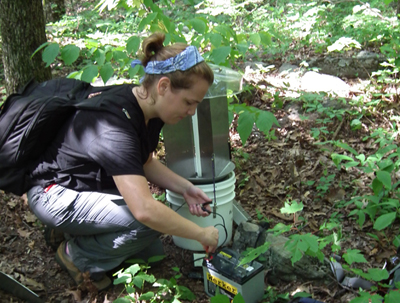
|
|
Habitat associations of birds at Furman Forest Tara Smith and Megan Aprill, both Biology mjaors of the class of 2012, conducted a survey of birds at the Furman Forest in 2012. They recorded 46 species of birds, but all had already been seen on the site. Red-eyed Vireos preferred creek habitat, while Blue-gray gnatcatchers were only seen in the “Blue Wall South’ area, suggesting a relationship with the small ponds on site. Eastern Wood Pewee preferred late successional, mature tree stands. Tara and Megan were supported by Furman Advantage grants.
|
 |
|
Habitat associations of small mammals Taylor Cannon conducted a survey of small mammals at Furman Forest in the summer of 2009, assisted by Tim Ward of North Greenville University and Corey McCubbin (an interested high school student). They laid 20-25 Sherman live traps in different habitats, and checked them on three consecutive days each week. They moved the traps to new locations every two weeks. They sampled small meadows and powerlines, hemock ravines, pine stands, deciduous forest, and marshy areas next to the two ponds on site. Species richness was surprizingly low, with only White-footed deer mice (Peromyscus leucopus), Eastern woodrats (Neotoma floridana), and Hispid cotton rats (Sigmodon hispidus) being caught in the traps. Additional sampling with motion-sensitive cameras documented the presence of bear, deer, rabbits, squirrels, raccons, and coyotes on the property. Photos of these species can be found in the taxonomic surveys section of this site Taylor's research was supported by a Furman Advantage grant and a grant from the Independent Colleges and Universities of South Carolina consortium.
|
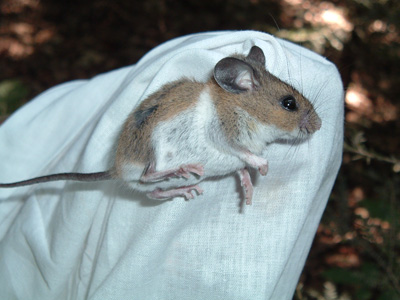 |
|
Woody Debris and Woody Riparian Vegetation in Urban and Rural Streams In summer 2012, Greg Lewis worked with two Furman students (Abbie Motes and Katie Murray) to compare abundance of woody debris (dead tree trunks and larger branches) as well as stream canopy cover and diversity of woody riparian vegetation in urban and rural streams in Greenville and the surrounding region. Measurements were made along a 100 m reach at each of 20 headwater streams. These streams drained watersheds of predominantly forest, mixed forest/pasture, high-density residential, or commercial land covers. A stream at the Blue Wall preserve was used as one of the forest stream sites. Surprisingly, neither the abundance of woody debris nor tree canopy cover differed significantly among the four watershed categories. However, the variability in the abundance of woody debris and in canopy cover was greater in urban than rural watersheds.
|
 |
|
Atmospheric Deposition of Ions Along an Urban-Rural Gradient Tim Moloney, an Earth and Environmental Science major (class of 2009), studied the deposition of ions in dust and gaseous forms (both considered forms of "dry deposition") to sites ranging from urban locations (in the City of Greenville) to rural locations (including the Furman Forest). Drs. Greg Lewis (Biology) and Brannon Andersen (Earth and Environmental Sciences) provided supervision. Students Serena Murphy (from Birmingham-Southern University), Valerie Caraballo, and Dalia Huguet (both from the Universidad Metropolitana in San Juan, Puerto Rico) also assisted in the project. Dry deposition was estimated by exposure of two artificial surfaces (glass Petri plates and paper filters) to the atmosphere for rain-free periods of about 2 to 4 days at 13 locations. Petri dishes were used primarily to collect dust particles, whereas filters were used to collect both dust and gases. Ion depositions measured by Petri dishes were not significantly correlated with distance from downtown Greenville. Ammonium and nitrate depositions measured by filters declined significantly with distance from the City of Greenville. Ammonium deposition also was significantly negatively correlated with percentage of forest cover within 2 km of each site. Overall, our results suggest that even smaller cities can influence atmospheric deposition of nitrogen and other elements, though perhaps not as strongly as larger cities. In this region, it appears that dry deposition of nitrogen in gaseous forms exceeds dry deposition in dust. Summarized From: Moloney, T.*, S. Murphy*, V. Caraballo, D. Huguet, G. P. Lewis, and C. B. Andersen. 2009. Relationships between atmospheric ion deposition and distance from an urban center in the South Carolina piedmont. 58th Annual Meeting of the Southeastern Geological Society of America, Abstracts with Programs, Vol. 41, March 12-13, St. Petersburg, FL.
|
 |
|
Mapping the distribution of canopy trees In order to provide an initial description of the habitat diversity in the Furman Forest, Dr. Wade Worthen began a survey of canopy tree species in Summer 2008. He has established a grid of over 500 sampling points, with 100 m between all points. At each point, all trees within an 8 m radius of the point greater than 2 cm in diameter are sampled; the species and size (diameter at ~ 1.5m) are recorded. These data will provide a description of how canopy tree communities change with elevation, proximity to watercourses, and land use history. Thiry-two species have been found so far. Of immediate interest is the infestation of wooly adelgids (sap sucking insects) that are killing Eastern Hemlock (Tsuga canadansis) trees. None of the hemlocks sampled thus far are free of adelgids. Other noteworthy observations are: 1) surprizing densities of American Chestnut (Castanea dentata) saplings, sometimes reaching heights of 5-7 m; and 2) a Northern Red Oak (Quercus rubra) with a diameter of 1.20 m - close (if not surpassing) the largest Northern Red Oak in South Carolina. This data set will also be analyzed with GIS technology, to look at the spatial patern to diversity and the relationships among and between different species of canopy trees.
|
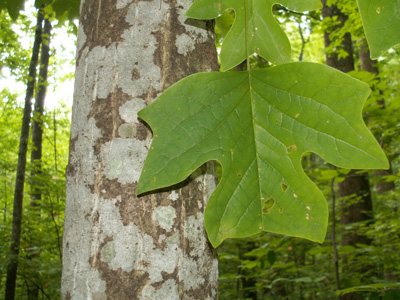 |
|
Seasonal change in the herpetofauna at two elevations As his Independent Research Project (BIO 502), Ben Delancey conducted an experiment on the seasonal changes in the amphibians and reptiles using refugia at two elevations. Plywood coverboards (1.3 m x 1.3 m) were used as experimental refuges. Ten coverboards were placed along 4 transects, at 20m intervals. Two transects were in the Tryon watershed and two were in the Landrum watershed. In each watershed, one transect was placed at ~500m in elevation and one transects was placed at ~650 m of elevation. Ben has been checking each coverboard at least once a week, recording all reptiles and amphibians and also measuring soil temperature beneath the coverboard. Ben tested the hypothesis that these ectothermic organisms will move up in elevation along these south facing slopes as fall proceeds. However, there was little evidence of a trend, as the cover boards were not used much in this first year. Ben also conducted a survey of herpetofauna (reptiles and amphibians) in Furman Forest, and is responsible for finding and photographing the specimens depicted in the taxonomic surveys section of this site.
|
 |
|
Microhabitat differences among Desmognathus salamanders The deep moist woods of the Southern Appalachian mountains is the worldwide center for salamander diversity; more salamander species occur in this bioregion than any other place in the world. Several species in the genus Desmognathus co-occur in mountain streams, including Desmognathus monticola, D. fuscus, D. ochrophaeus, and D. quadramaculatus. Biology major Ben Delancey, class of 2010, described how the ecological niches of different developmental stages of D. quadramaculatus might differ. As these salamanders grow, they become progressively more terrestrial. Smaller, younger salamanders remain in deep water, potentially to avoid cannibalism from the larger individuals that prefer the bank habitat. There are also interesting morphological changes that occur during development, with changes in the head width to length ratio that may correlate with differences in their diet. |
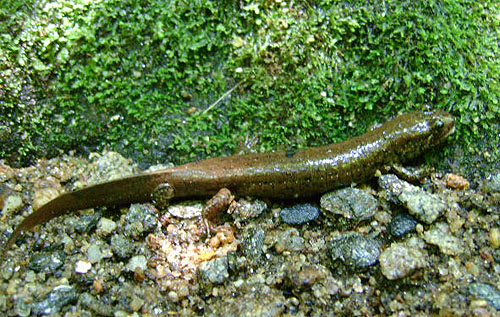 |
|
Perch selection by dragonflies In 2005 and 2006, Dr. Wade Worthen and Biology major Christopher Jones conducted experiments examining the relationship between perch height and body size in dragonflies. Perches are very important for defending territories and acquiring mates, so perch use is an importatn aspect of dragonfly biology. The two ponds on the Blue Wall Preserve (within the Furman Forest area) were included in this study, in addition to ponds at Bunched Arowhead Preserve in Travelers Rest, Furman Lake on the campus of Furman University, and an impoundment with the Sumter National Forest in Union County, SC. Worthen and Jones (2006, 2007) found that perch height was significantly correlated with body size; small dragonflies use low perches and larger dragonflies use progressively taller perches. This pattern could be due to aerodynamic constraints on dragonflies. As dragonflies increase in size, the mass increases as a cubic function of length but the surface area of the wings only increase as a squared function of length. So, the mass carried by each unit of wing surface area increases with body size; this is called "wing loading", and it must be offset by thrust in order for flight to be achieved. Thrust can be increased by headwind speed, which increases with height above the surface. So, large dragonflies may perch higher because they can fly more easily from taller perches where windspeed is greater. However, Worthen and Jones (2007) found no evidence for changes in perch height with wind speed, suggesting that wind speed is not contributing to perch height selection. Rather, larger species are competitively dominant in aggressive interactions for perches; larger species are more successful at displacing smaller species than the reverse (Worthen and Jones 2007). So, it appears that competition for perches contributes to the relationship between body size and perch height in dragonflies.
|
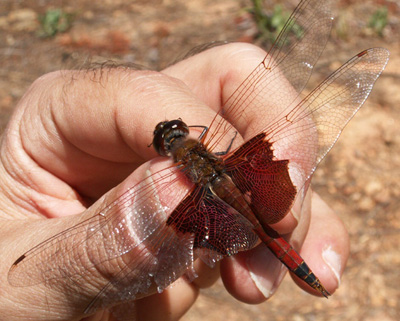 |